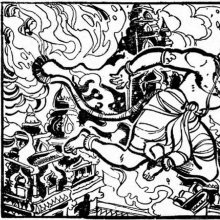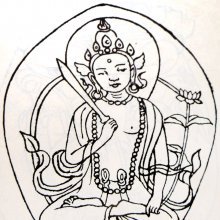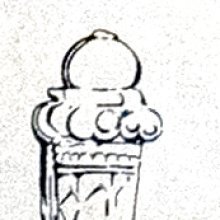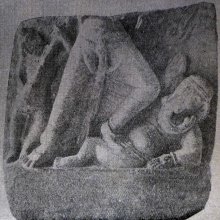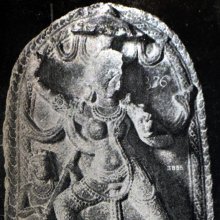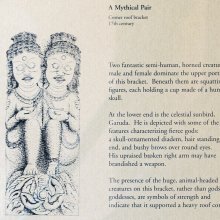Strength: 3 definitions
Introduction:
Strength means something in Hinduism, Sanskrit. If you want to know the exact meaning, history, etymology or English translation of this term then check out the descriptions on this page. Add your comment or reference to a book if you want to contribute to this summary article.
Images (photo gallery)
(+7 more images available)
In Hinduism
Yoga (school of philosophy)
Source: ORA: Amanaska (king of all yogas): A Critical Edition and Annotated Translation by Jason BirchStrength can be denoted by the Sanskrit term Bala, according to verse 81ab-82cd of the Dattātreyayogaśāstra.—Accordingly, “Then, from [even] more practice, abundant strength (bala) arises [in the Yogin], because of which [he gains] the Siddhi of moving across the earth, and he is able to conquer those who inhabit the earth”.

Yoga is originally considered a branch of Hindu philosophy (astika), but both ancient and modern Yoga combine the physical, mental and spiritual. Yoga teaches various physical techniques also known as āsanas (postures), used for various purposes (eg., meditation, contemplation, relaxation).
Pancaratra (worship of Nārāyaṇa)
Source: archive.org: Catalogue of Pancaratra Agama TextsThose seeking “Strength (and good harvests)” are advised to worship icons of Candra, as discussed in the twenty-eighth chapter of the Naradiya-Samhita: a Pancaratra document comprising over 3000 verses in 30 chapters presenting in a narrative framework the teachings of Narada to Gautama, dealing primarily with modes of worship and festivals.—Description of the chapter [sarvadevatā-sthāpanavidhi]: Nārada describes the worship appropriate to each god for specified ends: [e.g., Candra for strength and good harvests (102-107a)] [...]. In discussing next the shrine dedicated to each, he describes their shapes, proportions, the building materials used, the types and postures of the icons contained therein, [...].

Pancaratra (पाञ्चरात्र, pāñcarātra) represents a tradition of Hinduism where Narayana is revered and worshipped. Closeley related to Vaishnavism, the Pancaratra literature includes various Agamas and tantras incorporating many Vaishnava philosophies.
Jyotisha (astronomy and astrology)
Source: Journal of South Asian Intellectual History: Samarasiṃha and the Early Transmission of Tājika AstrologyStrength refers to one the “thirty-two astrological lots” (sahamas), as discussed in the fourth chapter of the Karmaprakāśa—one of the earliest preserved Sanskrit works on Perso-Arabic (Tājika) astrology authored by Samarasiṃha in the 13th century.—The so-called lots (Sanskrit: sahamas; Arabic: sahm, translating κλῆρος) are derived by measuring the longitudinal distance between two predefined points in a horoscope (typically two planets) and projecting it from a third point (typically the ascendant degree). Of these 32 lots [e.g., Strength], all but two are present in what has become the most widespread list of Tājika sahamas, compiled some three centuries later by Nīlakaṇṭha and comprising 50 items.

Jyotisha (ज्योतिष, jyotiṣa or jyotish) refers to ‘astronomy’ or “Vedic astrology” and represents the fifth of the six Vedangas (additional sciences to be studied along with the Vedas). Jyotisha concerns itself with the study and prediction of the movements of celestial bodies, in order to calculate the auspicious time for rituals and ceremonies.
See also (Relevant definitions)
Partial matches: Strength, Te.
Starts with: Strengthening.
Query error!
Full-text (+3250): Bala, Virya, Balabala, Samarthya, Shakti, Bahubala, Bhujabala, Sthasu, Ojas, Janghabala, Vikrama, Sthaman, Shushman, Pratibala, Dravina, Dardhya, Paurusha, Nagabala, Urja, Utsaha.
Relevant text
Search found 518 books and stories containing Strength, The strength; (plurals include: Strengths, The strengths). You can also click to the full overview containing English textual excerpts. Below are direct links for the most relevant articles:
Hayanaratna: The Jewel of Annual Astrology (by Martin Gansten)
15. How to Write Out a Complete Annual Horoscope (varṣa-pattra) < [Chapter 8 - Monthly and Daily Revolutions]
5. The Five Dignities (pañcavargī) < [Chapter 2 - Aspects and Dignities]
7. Other Calculations of Strength (bala-ānayana) < [Chapter 2 - Aspects and Dignities]
Yavanajataka by Sphujidhvaja [Sanskrit/English] (by Michael D Neely)
Verse 6.8 < [Chapter 6 - Rules Pertaining to Birth]
Verse 8.6 < [Chapter 8 - The Birth of Sovereigns]
Verse 8.37 < [Chapter 8 - The Birth of Sovereigns]
The Malaysian Journal of Medical Sciences
Malay Parent-Report SDQ: Reliability and Validity Study < [v.26(1): 1–158 2019 Jan]
Assessment of Prospective Physician Characteristics by SWOT Analysis < [Volume 19 (issue 1), Jan-Mar 2012]
Predicting Vertical Jump Height in Male and Female Martial Artists < [Volume 20 (issue 1), Jan-Mar 2013]
Journal bridging Ayurveda and Modern Science. < [Volume 30 (issue 4), Apr-Jun 2011]
Report on Local Health Culture in Primary Health Care Context < [Volume 5 (issue 3), Jan-Mar 1986]
Physico –chemical characteristics of tincture from asparagus racemosus willd < [Volume 16 (issue 2), Oct-Dec 1996]
Yoga-sutras (with Vyasa and Vachaspati Mishra) (by Rama Prasada)
Sūtra 2.34 < [Book 2 - Practice (Sādhana)]
Sūtra 3.23 < [Book 3 - Attainment (Vibhūti or Siddhi)]
Sūtra 4.14 < [Book 4 - Absolute Independence (Kaivalya)]
Guide to Tipitaka (by U Ko Lay)
Part 5 - Paiicaka Nipata Pali < [Chapter VII - Anguttara Nikaya]
Part 8 - Atthaka Nipata Pali < [Chapter VII - Anguttara Nikaya]
Part 7 - Sattaka Nipata Pali < [Chapter VII - Anguttara Nikaya]
Related products
(+62 more products available)
